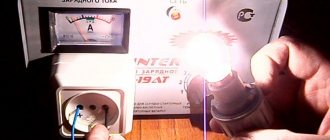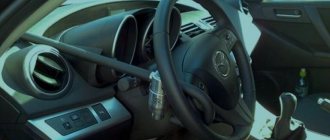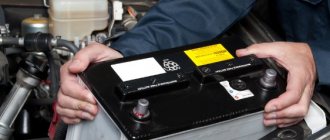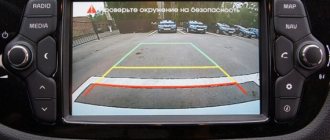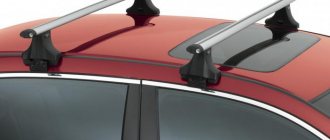Remember the old comedy "Beware of the Car"? “With a bad battery, is this really life?” In order for the battery to always behave well, it is impossible to keep it connected to the on-board network all the time; it needs periodic recharging from an autonomous charger, especially in winter; why - see below. It is possible to make a charger for a car battery with your own hands if you master basic electrical installation techniques. A homemade car charger made from randomly purchased components will cost less than a branded one; The case for modern electronics, I must say, is atypical. This is the first thing. Secondly, making a car charger with your own hands is a good transitional step from elementary electrical circuits such as a switch or a light bulb to serious electronics. Unlike the “pioneer” crafts on the table, it will immediately give you the skills to work with fairly large currents and mechanical design of the structure. This material tells you how to properly make a charger for a car battery.
Composition and terms
Autocharging consists of a primary power source for the charger itself, which provides a specified charging mode for the battery, and circuits to protect it from various types of emergency situations. Circuit design, these nodes can be combined to one degree or another. Below, for brevity, the following is used. abbreviations:
- AKB – rechargeable battery.
- PI is the primary power source.
- IP – any other power source.
- Ultrasound – protection device.
- TZ – current protection.
- ZN – overvoltage protection.
Charger for battery from computer power supply
Surely many car owners, especially those who lived under the Soviet Union at a time of total shortage of everything, had the opportunity to assemble a homemade charger for a car battery with their own hands. There are many circuits, ranging from the simple ones described above to complex ones that only professional electronics engineers can implement. Today you can create your own charger literally in a day from an old computer power supply (you need it to “breathe” at least a little - turn on the coolers). To assemble a charger with your own hands, you will need a 200–250 W unit (you can even use a very old one).
Why do you need charging?
Lead-acid batteries are distinguished by their “oakiness” and operational endurance, which is why they remain indestructible in vehicles. The reason is the simplicity of electrochemical processes in a lead-acid battery. To monitor its current state, in most cases it is enough to know the voltage of the entire battery without breaking it down into banks. But overcharging a lead-acid battery can cause the electrolyte in it to boil. This is very dangerous when the car is moving, so the battery in the on-board network is chronically undercharged. Constant undercharging leads to premature sulfation of the plates and a decrease in battery life. The situation is aggravated in the cold season, even if the garage or parking lot is heated, because... They are not heated to room temperature. If, in between trips, you recharge the battery to the maximum, how much energy it can accept at a given outside temperature, then the “Akumych” will live well and for a long time even in harsh conditions. The battery charger provides recharging for the battery, but that’s not all. A properly constructed charger also produces a desulfating effect. If in winter you remove the battery every day at night and put it on recharge, it can withstand the number of charge-discharge cycles 1.5-2 times compared to that prescribed in the specifications based on a typical operating mode. Also, charging with desulfation can sometimes save a battery that has been “dead,” for example, when trying to start a car in the cold. And finally, the capacity of an unused battery drops by 15-30% per month due to self-discharge. If during this time you put the battery under current from charging (see below), then the battery will always be fresh. And, by the way, putting an unused battery into maintenance also reduces sulfation of the plates.
Circuit diagram of a simple charger
According to the principle of operation, chargers can be transformer and pulse (electronic). While pulse devices are difficult to assemble on your own and have expensive components, other devices are based on only two components - a transformer and a rectifier. The operating principle of these chargers is to convert the 220 V household voltage into the voltage necessary to charge, for example, 12 volt batteries installed in a passenger car.
You can make a simple transformer battery charger with your own hands using the following options.
Circuit with one rectifying diode
The diode is installed after the transformer. The alternating current rectified with its help presents ripples with a sharp increase to a maximum value. The diagram and graph of the pulsating current are shown in the image:
Circuit with diode bridge
With the help of a diode bridge, the rectified current will remain pulsating, but no sharp beating will occur. This scheme is most often used for amateur creativity. Below in the text, as an example based on it, is a version of the practical implementation of a charger with your own hands.
Circuit with diode bridge and smoothing capacitor
The output is constant current, which is the best option for charging the battery. Despite the fact that charging will be a fairly long process, the operational life of the battery will remain quite long.
How does the battery work?
Lead-acid batteries are charged with a current equal to their 10-hour discharge current: 6 A for a 60 A/h battery, 9 A for a 90 A/h battery, 12 A for a 120 A/h battery. A higher current will cause overheating and, possibly, boiling of the electrolyte, causing the battery life to sharply decrease until it becomes completely unusable. A lower charging current practically does not increase the battery life, but lengthens the charging time.
The charging current in the battery flows back to the worker. The most important condition for this is that the voltage on the battery should not exceed 2.7 V per cell (8.1 V for a 6 V battery, 16.2 V for a 12 V battery, 27 V for a 24 V battery), otherwise chemical decomposition of the electrolyte will begin, plates, and the battery will boil even with a small charging current. To completely eliminate boiling, the permissible charge voltage is limited to 2.6 V per can (7.8 V, 15.6 V, 26 V, respectively); in this case, the energy undercharge will be less than 5% and there will be no increase in sulfation.
If you disconnect a fully charged battery from the charger, let it cool and measure the voltage without load, we will see 2.4 V per cell (6.8 V, 14.4 V, 24 V). During discharge, the battery voltage gradually drops to 1.8 V per cell (5.4 V, 10.8 V, 21.6 V), after which the battery is considered completely discharged. In fact, it contains approx. 25% of the energy “pumped” during charging, and there are ways to “suck” it out in an emergency until the last erg, but after that the battery will have to be recycled. You can't throw it away, it contains lead.
The temperature dependence of the voltage of a fully charged battery is significant. If you give a charge to a battery that has not yet cooled down from the extra current of the discharge (the starter takes up to 600 A at the moment of starting, and the torque up to 75 A), then the voltage on it can jump sharply, because The response of a lead battery with current consumption to a jump in the applied voltage is very delayed, by electronics standards, up to tens of ms. We will get self-heating and boiling of the electrolyte on board. Therefore, in the car’s electrical system, the voltage on the battery is limited to 2.35 V per cell (7.05 V, 14.1 V, 23.5 V), which causes chronic undercharging.
When charging from an external charger, the voltage on the battery is limited to 2.4 V per cell (6.8 V, 14.4 V, 24 V), because “pour energy up to the neck”, up to 2.6 V per can, is risky - the battery gets hot when charging and can go into self-heating. The battery is fully charged and protected from self-discharge by the so-called. maintenance current equal to 0.5-1 100-hour discharge current (0.3-0.6 A, 0.45-0.9 A and 0.6-1.2 A for a 60 A/h battery, 90 A/h and 120 A/h respectively); The voltage on the battery should not exceed 2.6 V per cell. In practice, for this purpose, the charger is equipped with overvoltage protection of 15.6 V for a 12 V battery, 7.8 V and 26 V for a 6 V and 24 V battery. If it works, the battery has received as much energy as it can and cannot be charged further.
Types of charging for batteries
The process of charging batteries is the restoration of lost power. To do this, use special terminals that produce constant current and constant voltage.
It is important to observe polarity during the connection process. Incorrect installation will result in a short circuit, which will cause parts inside the vehicle to catch fire.
Experienced motorists recommend using direct current. It will take a long time to restore power, but without shortening the service life of the parts. On average, this time ranges from 10 to 15 hours.
To quickly reanimate the battery, it is recommended to use constant voltage. It can restore the car's functionality in 5 hours.
Read here: DIY armchair - step-by-step instructions for creating upholstered furniture. Designer tips for designing chairs
Charging Requirements
Based on the operating conditions of individual vehicles and the specified conditions of the battery charging mode, the requirements for a charger for a car battery are as follows:
- A homemade charger for a car battery must be autonomous, not requiring supervision and control of the charge current/voltage, because The battery will be charged mainly overnight;
- The PI memory must provide a stable voltage of 14.4 V, acceptable in the case where there is a voltage drop across the US, 15.6 V;
- The ultrasonic switch must ensure irreversible disconnection of the battery from the charger both when the charging current is exceeded and when the voltage on the battery increases above 15.6 V. Irreversible means that the ultrasonic switch must be self-locking, i.e. to reset it to its original state, you will need to turn off and turn on the IP again;
- Also, the ultrasound must provide protection against polarity reversal, i.e. Incorrect, reverse polarity, battery connection. If the conditions in clause 3 are met, protection against polarity reversal is provided automatically.
About polarity reversal
In case of battery polarity reversal, 2 cases are possible: the battery is serviceable, undercharged or deeply discharged and/or “profitable”, depleted, and has largely exhausted its resource, or a fully charged battery is incorrectly connected to the charge. In the first case (properly undercharged), the charge current increases above the nominal one. In the second, before this, the battery voltage will “jump” for a short time above the specified IP, and then the extra current will immediately “jump” and the battery will boil. In the latter situation, in order to save the battery from irreparable damage, it must be turned off due to overvoltage.
No need!
Let's first talk about typical mistakes in designing homemade chargers for lead batteries. The first is illustrated by pos. up. Connecting directly to the household electrical network (left) is not worth discussing. This is not a mistake, this is a gross and dangerous violation of safety regulations. The error is in limiting the charging current by capacitive ballast. Expensive, by the way, this is a method by today's standards: the battery of oil-paper capacitors alone at 32 uF 350 V (lower voltage is not possible) costs more than a good branded charger.
Incorrectly and irrationally constructed charger circuits for car batteries
But the main thing is that a reactive load appears in the network. If your electric meter has a reactivity indicator (LED “Return”), then when these charges are plugged into the network it will flash. Managing modern electrical equipment is impossible without computers, and the “return” confuses the electronics even to the point of shutting down due to a false alarm. That's why today's electricians are merciless when it comes to reactive power. Well, what if it turns out that its source is illiterate or an overly cunning consumer, then... let’s not look into the night.
The circuit below, if we take into account the same capacitive ballast, was developed skillfully, this charger will protect the battery, figuratively speaking, from the Tunguska meteorite; (a detailed description of it can be found here: https://ydoma.info/avtomobil-zaryadnoe-ustrojstvo-dlya-avtomobilnogo-akkumulyatora.html). But, with all due respect to the author, who certainly knows his business, building such a difficult (and expensive) charger for lead batteries is like assigning a nanny from a kindergarten to command a platoon of experienced, seasoned soldiers. A lead battery needs little to live well. What will we do next?
How to make a charger for charging a car battery with direct current
You will need a device that produces a constant voltage exceeding e. d.s. battery In practice, this is 16.2 V. The source can be automatically adjusted (which is preferable) or manual.
Features of charging a car battery with direct current
During operation of the device, it is necessary to take into account the polarity: “plus” is connected to the “plus” of the battery, “minus” to the “minus”. Only after connecting the wires, insert the plug connector into a 220 V socket.
Using direct current causes some difficulties when compared with voltage charging. The main nuance is the need to maintain the same current value. The easiest way to do this is to use a regular rheostat. But then you will have to constantly monitor the process and, if necessary, adjust the charge current. Another method is to use a special electronic circuit with thyristors, then the required current is maintained automatically:
- 0.1 of the battery capacity, process time 10 hours;
- 0.05 of the battery capacity, the process lasts 20 hours.
If the homemade charger is powerful, you can use 2–3 or more car batteries at the same time. Their number is calculated as follows:
M = In/Ia,
where the first character is the number of battery groups,
Ia – charge current strength,
In – current coming from charging.
The latter can be calculated using another formula: In = Pz/U. Here the second symbol indicates the power of the charger, the third – the voltage of the network from which the charging is powered.
The main advantage of charging a battery with direct current is the ability to complete the process at 100%. This significantly extends the service life of the product. The lower the charge current, the deeper it is. But no time for fanaticism! If the current is too low, the process will drag on indefinitely. On the other hand, if the charge is too intense, the battery will boil and will not be fully charged. However, there are also disadvantages of this method:
- the need to constantly maintain a certain current value;
- strong release of gases;
- possible heating of the product.
You can avoid such troubles by assembling a charger for a car battery with your own hands with a two-stage cycle. First, a current of 0.1 of the battery capacity is applied, U = 14.4 V, after which the current is halved. The total process time is related to the degree of battery discharge. Charging continues until the electrolyte density meets the standard. This is approximately 10–12 hours.
Protection
UZ for a battery is like armor for a tank, so let's start with it. It is advisable to make the ultrasound for a homemade battery charger, of course, simpler. Further, it is also advisable to build the battery autonomously, so that through it you can connect the battery to any charger whose circuit you like, or which you already have. And lastly, the ultrasound must operate as clearly and quickly as possible in order to be able to use it in charging circuits for modern batteries with sealed banks.
Ineffective car battery protection schemes
The simplest protection against polarity reversal using Schottky diodes (on the left in the figure) will not save you from overcharging extra current or from incorrectly connecting a serviceable undercharged battery. Unless by burning an expensive diode assembly. If the battery is “new, good”, then until your hands reach the “new, good” charger, the integrated protection according to the diagram on the right can help out; it can be built into an existing homemade laboratory IP.
This circuit uses the slow response of the battery to a voltage surge and the hysteresis of the relay: their release current (and voltage) is 2.5-4 times less than the operating current/voltage. Any battery charger is turned on only with a connected battery. The relay is an alternating current one with an operating voltage of 24 V and a current through the contacts of 6 (9, 12) A. When the charger is turned on, the relay is activated, its contacts close, and the charge begins. The voltage at the output of the transformer drops below 24 V, but at the output of the charger there remains 14.4 V, set in advance under load R3 in the voltage stabilization circuit. The relay is still holding, but suddenly there is an extra current, the primary voltage will drop more, the relay will release and the charging circuit will break.
This memory has serious disadvantages. Firstly, there is no protection against a voltage surge at the output due to polarity reversal of a depleted battery. Secondly, there is no self-locking: from the extra current the relay will clap and clap until the contacts burn out. Thirdly, unclear operation: any relay due to undervoltage on the winding releases with contact chatter. Therefore, trying to introduce control of the operating current into this circuit is pointless. And finally, the relay and transformer T1 must be matched to each other, i.e. The repeatability of this device is close to zero.
The ultrasound scheme, which fully complies with the above requirements, is shown in Fig.:
A simple scheme for protecting a car battery from overcharging, overvoltage and reverse polarity
The charging current flows through the normally closed contacts of relay K1, which greatly reduces the likelihood of them burning. Winding K1 is connected via a diode “or” logic circuit to the overcurrent protection module (R1, VT1, VD1), the overvoltage protection module (R2, R3, R4, VT2, VD2) and the self-locking circuit K1.2, VD3; the overvoltage response threshold K1 is set by R3. This ultrasound has only one drawback; it needs to be adjusted using a ballast load and a multimeter:
- Solder (or not yet solder) K1, VD2 and VD3.
- Instead of winding K1, turn on a multimeter set to measure a voltage of 20 V.
- Instead of a battery, connect a resistor of at least 25 W with a resistance of 2.4 Ohms for a charge current of 6 A, 1.6 Ohms for a charge current of 9 A and 1.2 Ohms for a current of 12 A; it can be wound from the same wire as R1.
- A voltage of 15.6 V from the charger is supplied to the input. The multimeter will show the voltage (current protection has tripped), because resistance R1 is selected with a slight excess.
- Reduce the charger voltage slightly until the multimeter shows 0. Record the resulting value of the charger output voltage. The alternative is a constant memory voltage and labor-intensive adjustment of R1.
- VT1 is unsoldered, K1 and VD2 are soldered in place, the R3 engine is placed in the lowest position according to the diagram.
- The charger voltage is increased until the load reaches 15.6 V.
- Smoothly rotate the engine R3 until K1 is activated.
- Reduce the voltage of the charger to the previously recorded value.
- VT1 and VD3 are soldered into place - the circuit is ready for final tests.
- A serviceable, undercharged battery is connected through an ammeter; next to it is a multimeter set to voltage.
- The test charge is carried out with continuous monitoring. When the multimeter shows 14.4 V on the battery, the content current is detected. Most likely it will be normal for this battery (see above); preferably closer to the lower limit.
- If the content current is too high, reduce the voltage of the charger a little more.
Note: in order not to cut nichrome many times for R1 - its resistivity is 1 Ohm*m/sq. mm. That is, 1 m of nichrome wire with a cross section of 1 square. mm has a resistance of 1 ohm.
PI or UPS?
These days, a computer switching power supply (UPS) may be more affordable than a hardware transformer; suddenly he’s just lying around in the trash. UPSs are often converted into laboratory power supplies, but, generally speaking, this is a bad option. The output voltage via the +12 V channel can be raised to a maximum of 16-17 V, which is not enough for design and research purposes. And the level of impulse noise at the output is then, to put it mildly, too high. How to set up an UMZCH with its own noise of -66 dB (which is still very modest), if the power supply is “rushing” at -44 dB or worse? But charging a 60 A/h car battery from a UPS is excellent, and there is no need to install separate protection, everything is already there. They convert the UPS into an auto charger, as a whole, the following. way:
- Remove the output wires except yellow (+12 V), black (common, ground, GND) and the green PC ON logic wire;
- The PC ON wire is short-circuited to ground (connected to any of the black ones);
- Install a mechanical power switch if there is no standard one at the back;
- Using the diagram or guided by your own experience, look for a +12 V resistor in the feedback circuit Rcs in the stabilizer harness;
- Replace it with a 10 kOhm Rn potentiometer;
- By rotating the Rн slider, set the voltage in the +12 V channel to +14.4 V;
- The resulting value of Rн is measured and instead of Rcs, a constant resistor of the nearest value from the standard series is soldered in, the tolerance for variation is up to 2%;
- If possible, a universal voltage and current indicator (see below) is built into the UPS to control the charge; it is powered from the charge circuit or +5 V (red wire);
- Connect the yellow and black wires into separate bundles, securely attach current hoses with clamps for connecting to the battery to them - charging is ready!
Note: you can see two detailed options for converting a UPS into a battery charger in the video below.
Video: examples of converting computer power supplies into battery chargers
IP
If you don’t have an extra UPS at hand, then for an IP charger you need to look for a transformer on hardware, its own time constant (electrical inertia) is greater than that of the battery, which is very good for safety of use. In no case is it necessary to “sculpt” a homemade UPS; its output time constant is 2 orders of magnitude less than that of a battery. A homemade UPS for a charger without complex built-in protection circuits can cause all sorts of emergency situations. Remember - boiling electrolyte results in fog and splashes of strong poisonous acid! And if the battery has sealed jars, then it may explode!
The IP charger consists of a step-down transformer and a rectifier. A smoothing filter is not needed for battery charging. It is recommended to look for a power transformer with incandescent windings from old tube TVs - TS-130, TS-180, TS-220, TS-270. In terms of power, they are more than adequate, but, firstly, they are not protected from moisture in any way, and they may not survive the winter in the garage. Secondly, specialists in secondary metals are well aware of how much revenue the vehicle generates, and they are becoming increasingly difficult to find.
Step-down transformers of TP and TPP types
If there is no desire and/or opportunity to calculate and wind the transformer yourself, for an IP charger it would be better to buy a TP or TPP transformer, they are cheaper than a used UPS. Power - from 50 W, it is indicated by the last 2 digits in the designation of the standard rating, for example. CCI 36-220-80. The 3 digits in the middle are the operating voltage of the primary winding, and the first 2 or 3 encode the number and voltage of the secondary windings, it is 6.3 or 12.6 V per winding. Preference should be given to transformers in a vapor-moisture-proof design (“green”, on the left in the figure); they are capable of operating for an unlimited time in an atmosphere with a humidity of 100% and impurities of chemically aggressive vapors. A transformer with windings on a fusible plastic frame (right) is an option for the most extreme cases. These are not designed for operation under charging conditions: operating more than 50% of the time of use at full power with systematic overcurrents. Suddenly you take one, its power is needed from 120 W.
Note: It is better to take TP and TPP for one primary voltage of 220 V, such, other things being equal, are 10-15% cheaper.
Typical connection diagrams for 12.6 V TC and TPP windings for bridge rectification or full-wave rectification with a midpoint are shown in Fig. left and right:
Connection diagrams for windings of typical power transformers
They may differ for a particular instance, because Manufacturers have the right to arbitrarily change the pinout according to the customer’s specifications. The remainder goes on sale, and the production of a particularly popular standard denomination can be continued for the market. Therefore, when purchasing a TP or CCI, check the specification for it; if it is not there, you will have to call the windings. The general rules for routing pins and connecting windings of TC/TCP are as follows:
- Network (primary) windings are output to the first numbers.
- Interwinding screens are displayed on the last numbers.
- To connect the windings in parallel, odd terminals are connected to odd terminals; even - with even.
- To connect the windings in series, the odd terminals are connected to the even ones.
Note: screen pins (15 and 16) can be combined as desired, because interwinding screens are not short-circuited turns.
A cheaper option is to look for an old TN incandescent transformer at the iron market; The designation system is similar to TP/TPP. “Treasure hunters” are not keen on TNs: there is a lot of fuss with disassembly, not enough copper. A typical circuit diagram for connecting a voltage transformer for a charger is given in the inset in the center of Fig. To increase the output voltage, you cannot switch the lower diode in the circuit from pin 15 to pin 16; the symmetry of the windings will be broken!
Schottky rectifier
The output voltages in the diagrams above are given for an input (mains) 220 V. If it drops, there will be undercharging. At the same time, since the battery is charged from an external charger cold, there remains some margin for increasing the charging voltage; it can be used completely if the memory is protected. In this case, the rectifier must be made with a midpoint on the Schottky diode assembly - the output voltage will increase by approx. at 0.6 V.
Modern Schottky diodes with a platinum barrier are quite suitable for use in battery chargers, see the specification in the figure:
Specification for the assembly of Schottky diodes for the rectifier of the car battery charger
In addition, an assembly of a pair of Schottky diodes requires a radiator of 50 square meters. cm, and for each ordinary one, with a pn junction, for a current of up to 10 A - from 100 sq. see. You need to take Schottky assemblies with a maximum reverse voltage of 35 V and a peak forward current of 30 A, because in a rectifier circuit with a midpoint, respectively. the values reach 1.7 amplitude voltage of the secondary winding and 2.4 rectified current (31 V and 24 A at 12.6 V and 10 A; the initial peak charging current of a completely discharged battery at 60 A/h is 10 A).
A simple thyristor-based battery charger
In essence, we are talking about a thyristor regulator. The attached circuit does not contain a protection unit, control module or other bells and whistles. Simplicity and a minimal number of parts determined the popularity of this simple design.
The question arises: isn’t it easier to purchase a ready-made thyristor device in a store? It seems like this is what needs to be done. But factory-made, inexpensive chargers have some problems. For example, the current is adjusted by a solid switch, which simply decreases or increases the turns in winding II of the transformer. Due to this, the current increases or decreases. It turns out roughly, stepwise. And higher quality memory is quite expensive. Therefore, it makes sense to make a simple charger with your own hands. Pros:
- availability of electronic components and their low cost;
- ease of finding the required circuit (via the Internet);
- smooth regulation of charging current (range 1010 amperes);
- use of pulse current, which extends the battery life;
- easy setup;
- stable operation.
The principle of operation of the circuit and the selection of parts
Here is a phase-pulse regulator, where the main elements are thyristors. Below the text is an accessible diagram of a charger for a car battery:
Electronic components of a charger for a car that you want to assemble with your own hands, taking into account the designation:
- C1 – from 047 to 1 µF at 63 V;
- R1 with a resistance of 6.8 kOhm (P = 0.25 W);
- R2 at 300 Ohm;
- R3 at 3.3 kOhm;
- R4: 110 Ohm;
- R5: 15 kOhm;
- R6: 50 Ohm;
- R7 at 150 Ohm power 2 W;
- VD1 – pulse type diode, reverse voltage from 50 V;
- VS1 – thyristor T-160, 250 or KU202;
- transistors with direct junction KT315 or similar (KT3107, etc.);
- transistors with reverse transition KT361, KT 3102, etc.;
- FU1: 10 A fuse (a 15–20 A part is suitable, with a margin).
The thyristor is affected by components VT1 and VT2. Then the diode comes into operation, protecting the circuit from voltage surges that occur on VS1. R5 in a homemade battery charger “calculates” I = 1/10 of the capacity. At 60 A/h, a 6 A charge is used. To know for sure, it is advisable to insert an ammeter on the contacts leading to the product being charged. This will allow you to maintain control over the process.
Now about nutrition. The circuit of a homemade charger for a car battery involves the use of a transformer that produces from 18 to 22 V. For a higher value, increase the resistance of R7 to 200 Ohms. Do not forget to secure the diode bridge elements to cooling aluminum radiators (use special paste). It is worth noting: the use of old-style diodes of the D242 type implies their installation on the radiator through insulating washers. The fuse rating must match the current applied. If this is up to 6 A, then 6.3 A is quite enough for FU1. Below is a diagram for chargers for a car battery (back side of the printed circuit board):
In addition to the fuse, there are electronic ways to guarantee against short circuits and polarity reversal, which leads to failure of the charger. For example, you have a product where it is no longer possible to distinguish between “plus” and “minus”. Then a special circuit will help, signaling that the terminals are connected incorrectly. It must be connected in series between the battery and charger:
Parts used:
- R1 and R2 – resistors with a resistance of 510 Ohms;
- VD1 and MB2 – diodes (for example, 1N4148 or similar);
- VD3 and MB4 (can not be installed);
- any relay for 12 V and 15 A (can be pulled out of your old UPS);
- any LEDs.
The scheme works simply. If the polarity is observed, the charge still present in the battery will close the relay contacts, the process will begin, which will be confirmed by the green LED lighting up. If the contacts are reversed, the red indicator will light up. Below is a printed circuit board of a device that protects against reverse polarity when charging:
About thyristor rectification
The scope of application of controlled thyristor rectifiers is limited due to the large switching noise they create on the rectified voltage. But in the charger these interferences are not a hindrance; the battery will extinguish them. But in terms of other properties, thyristor rectifiers for charging batteries are not only suitable, but ideal.
The fact is that after thyristor rectification without smoothing, the charging current is supplied to the battery in short pulses with a cut-off edge of increased (but not excessive) amplitude. As a result, charging a car battery with a thyristor rectifier gives a desulfating effect without any additional tricks. And, what is also important, the probability of the battery going into self-heating when charging from a thyristor charger is an order of magnitude less: unnecessary electrochemistry has time to dissolve in the intervals between pulses. Another plus is the same as for Schottky diodes: a radiator for a pair of thyristors needs the same area as for the Schottky assembly.
For the sake of simplicity, thyristor chargers are often built using a half-wave rectification circuit, see figure:
Thyristor chargers for car batteries with half-wave rectification
The bottom scheme is the cheapest, because To control a power thyristor, instead of a low-power thyristor, its transistor analogue is used; it is two to three times cheaper. The circuit on the top right is the most expensive due to the very expensive industrial thyristor T122-25, which also requires an anti-noise filter C1T1C2. Otherwise, these memory devices are equivalent.
Half-wave thyristor memory devices have one, but fatal, drawback - that same half-wave rectification. Half of the primary half-waves of current are lost. In order not to double the charge, you have to resp. increase the amplitude of the charging pulse. It goes beyond the permissible limits, and the advantages of thyristor rectification are negated. On the contrary, a half-wave thyristor charger is more dangerous for the battery than a diode charger.
Charger circuits for car batteries with full-wave thyristor rectification retain all its advantages and are free from the above disadvantage. But an appropriate approach to constructing a thyristor rectifier is needed. For example, the diagram on the left in Fig. – typically amateur. The rectifier is made similarly to a diode bridge, which doubles the voltage drop across it and requires a couple of completely unnecessary, rather expensive components. The switching interference from such a charger is strong, and you need to wind an atypical transformer.
Schemes of thyristor chargers for car batteries with full-wave rectification
The well-known Amperus auto-charging circuit is close to the optimal one for thyristors, on the right in Fig. Its authors also took care of good anti-noise isolation of control circuits, which allows Amperus to be used in an apartment. The only small drawback is that the charge current and voltage are interdependent, because are set together with a 1 kOhm resistor. Therefore, it is advisable to use Amperus with ultrasound (see above).
How to make a starter charger
Making your own starting-charging device that will allow you to easily start the engine even when the battery is dead, although not easy, is quite possible. The principle of operation of the device is simple - the mains voltage is supplied to the transformer winding, where it is smoothed out and acquires the necessary properties.
Step-by-step instructions on how to make a car charger with your own hands:
- Select a wire for the primary winding with a cross-section of at least 37 square meters. cm and for the subsequent secondary winding a wire with a cross-section of at least 2 square meters. mm
- Purchase a core from a store or take it from an old transformer. You need to make a winding on it, the number of turns of the primary winding should be about 265 - 300, the secondary - 15-18.
- Check the no-load current with a multimeter, which should show a value of about 200 A. If the reading is higher, then the number of turns needs to be increased, if less, then increase accordingly.
- Next, thyristors are connected, then diodes or a dioid bridge, and finally transistors.
- Finally, resistors, a switch and wires are connected, with the help of which the transformer will be connected to the battery and charging socket. The charging cable must have a regular plug. The wires can be left open, and they will be connected using ordinary “crocodiles”.
After this, the starter-charger is ready and can be used.
